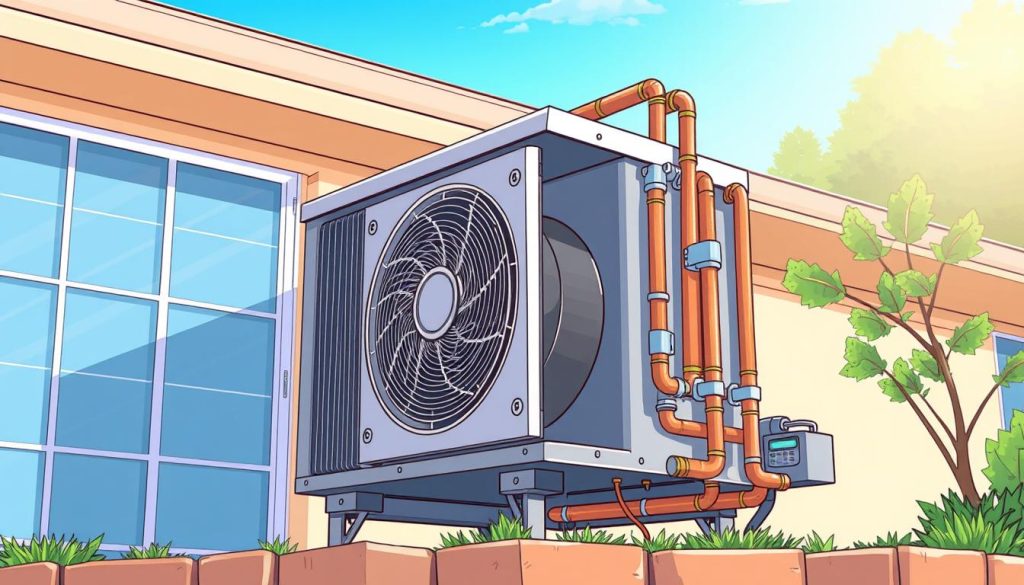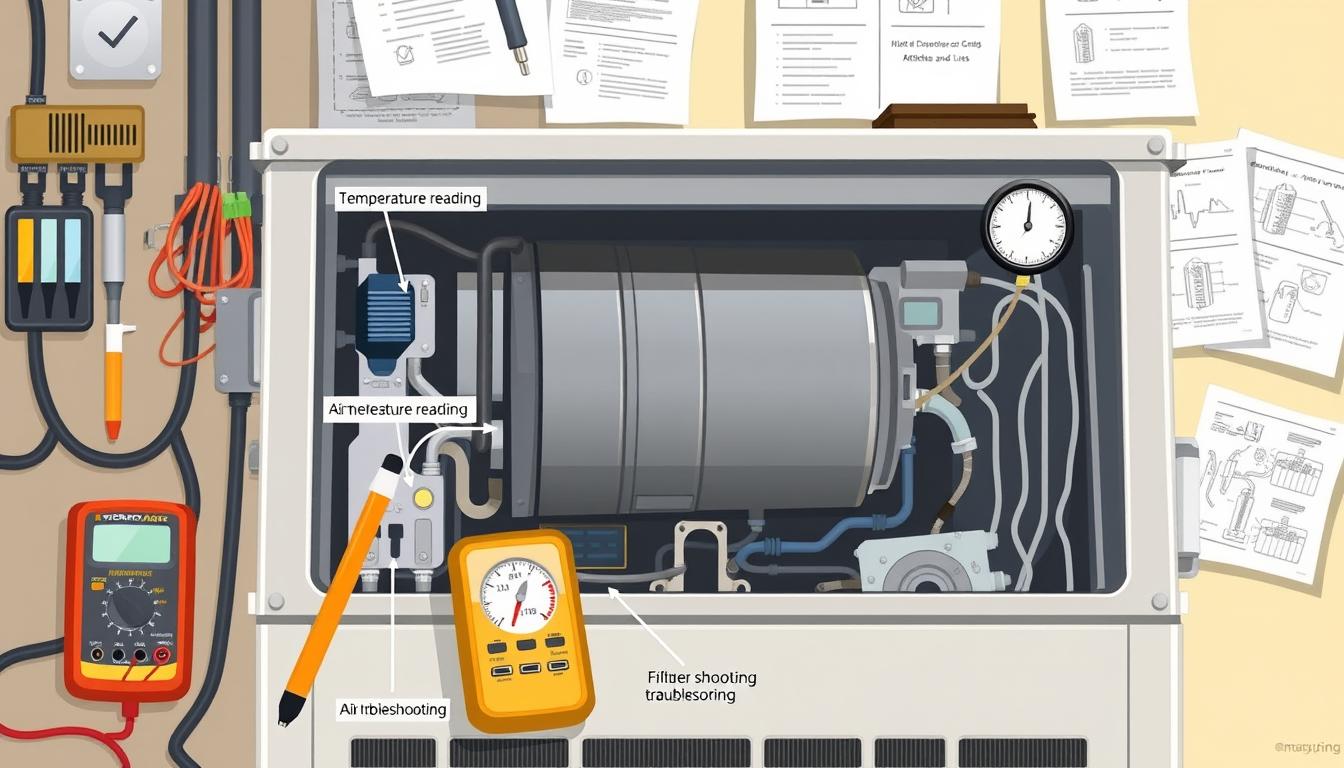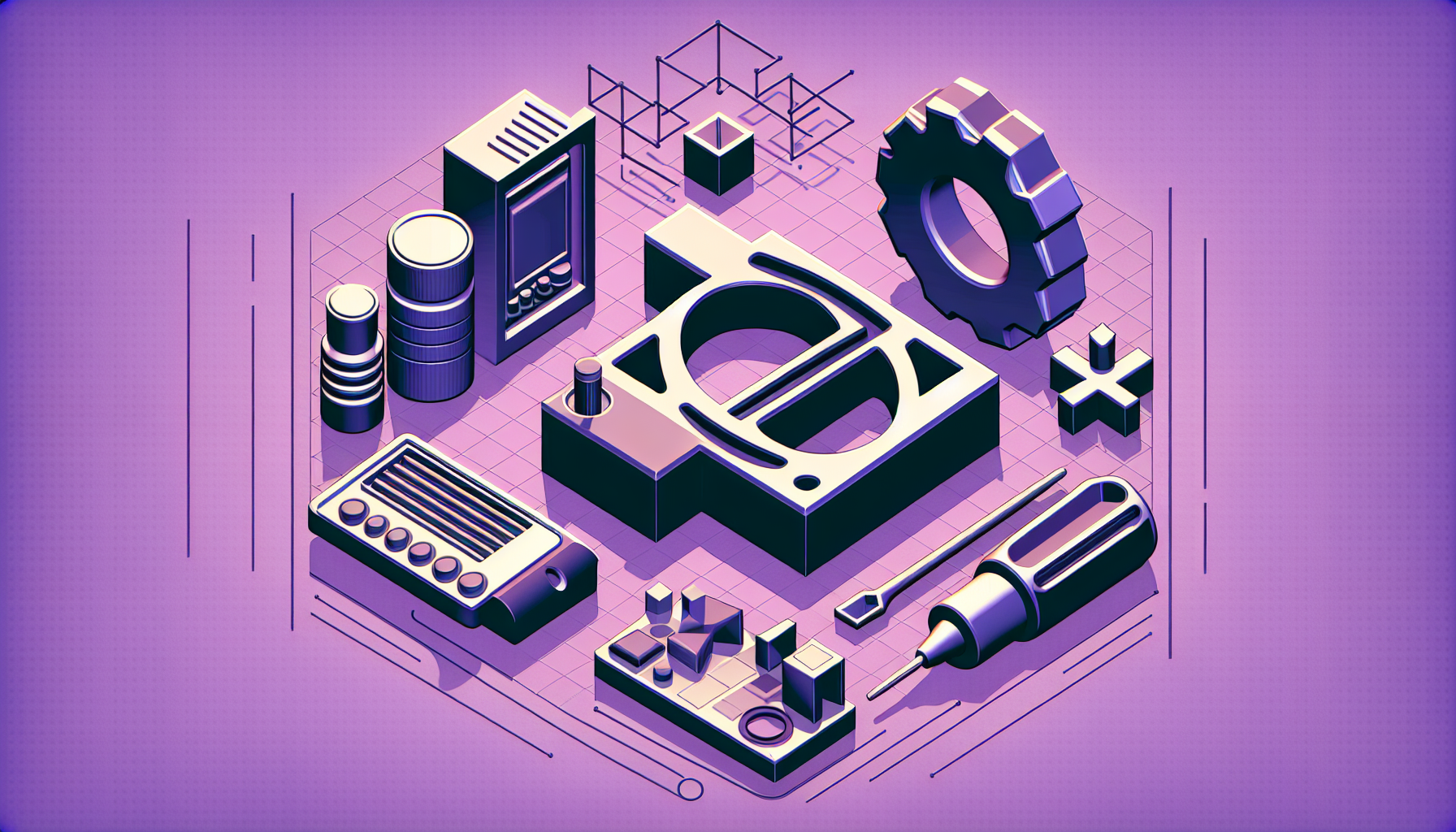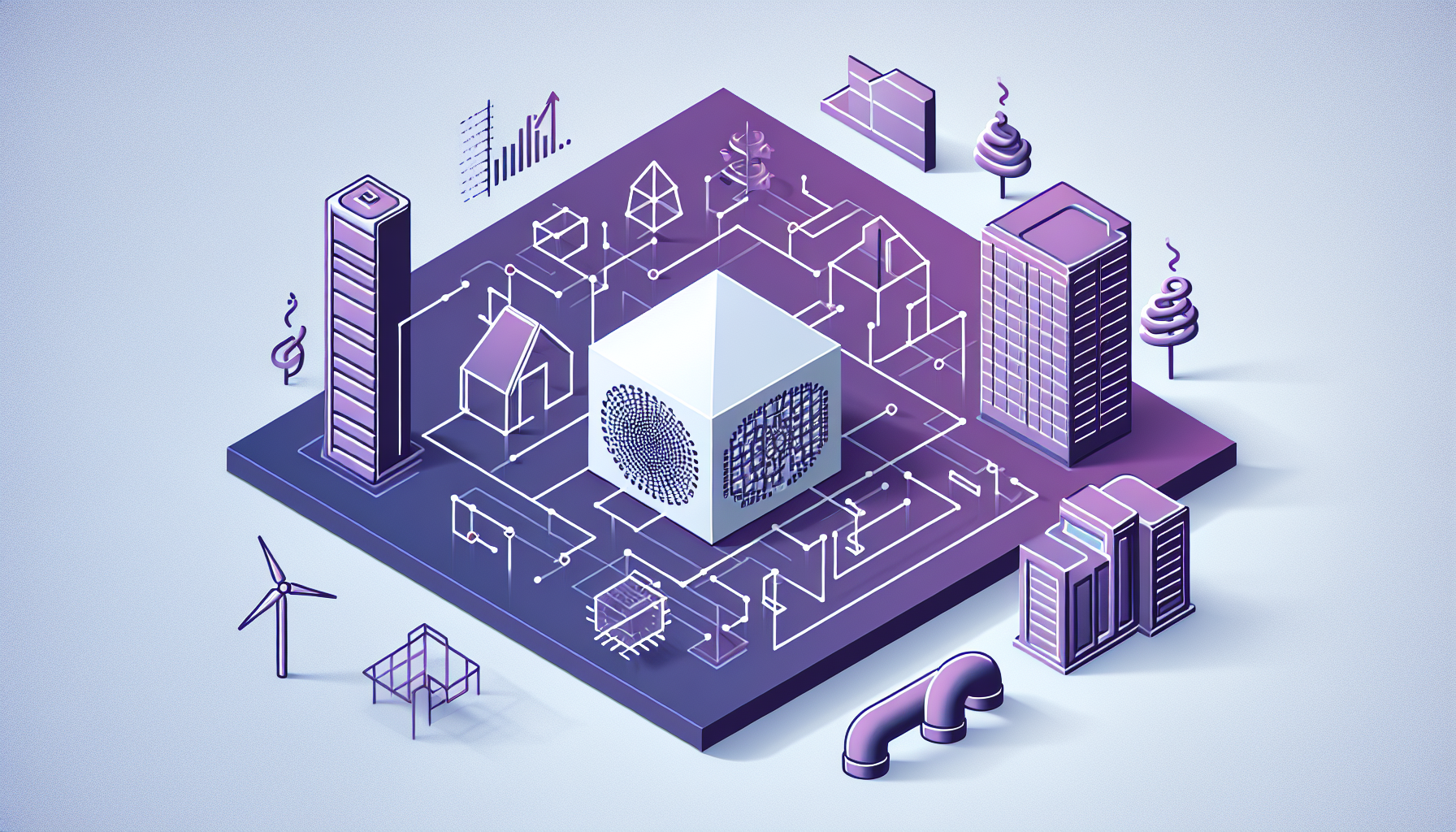If your air conditioning system isn’t working right, you need to find out why fast. This guide will help you fix common AC problems. You’ll learn how to get your cooling system working again. By using these tips, you can avoid expensive repairs and keep your home cool and comfy.
Key Takeaways
- Identify and address common AC issues, such as dirty air filters, thermostat malfunctions, and tripped circuit breakers
- Inspect the outdoor unit and check for blocked air vents to maintain proper airflow
- Assess refrigerant levels and look for signs of a frozen evaporator coil to pinpoint the root cause
- Examine the condensing unit to ensure it’s functioning correctly and not causing any problems
- Follow step-by-step troubleshooting guides to diagnose and fix your air conditioning system
Check for a Dirty Air Filter
Your air conditioning system needs a clean air filter to work well. A dirty or clogged air filter can cause many problems. These issues can hurt your AC unit’s performance. It’s important to know how to fix these problems to keep your home comfortable and energy-efficient.
Common AC Problems Caused by Dirty Filters
A dirty air filter can really mess with your air conditioning system’s airflow. This can lead to several big problems:
- When airflow is restricted, your AC unit has to work harder. This means higher energy bills and less cooling power.
- A clogged air filter can also cause ice to form on the refrigerant lines and freeze the evaporator coil. This makes it hard for your system to cool your home properly.
- Bad airflow from a dirty filter can also cause water leaks and other issues. These problems can even make your air conditioning system fail completely.
Solution
The fix for these air conditioner airflow problems is easy: just check and replace your air filter regularly. You might need to change it every 1-3 months, depending on your AC’s use. Keeping your air filter clean helps avoid expensive repairs and keeps your home cool all season.
Check Your Thermostat Settings
Your thermostat is key to your air conditioning working right. Wrong thermostat settings can cause problems like uneven airflow and warmer temperatures. It can even stop your AC from turning on. So, it’s important to check your thermostat settings.
First, make sure your thermostat is set to “cool” mode. This tells your AC to cool your home. Also, the fan should be in “auto” mode. This lets the fan turn on and off as needed.
Then, check if the temperature setting is right. If it’s too high, your AC won’t turn on. If it’s too low, it will run too much, wasting energy and money.
By checking your thermostat settings carefully, you can fix many AC problems. Fixing incorrect thermostat settings is a simple way to solve common AC issues.
Inspect Your Air Conditioner Circuit Breakers
If your air conditioner won’t turn on or keeps tripping the circuit breaker, it might be an electrical problem. First, check the circuit breaker for your AC unit. Air conditioner electrical problems often cause it to not turn on.
Signs of a Tripped Circuit Breaker
The most obvious sign is when your air conditioner won’t start. You might also see the circuit breaker switch in the “off” position. Sometimes, the breaker looks like it’s on but has actually tripped and needs to be reset.
Resetting the Circuit Breaker
- Find the circuit breaker for your air conditioning, usually in your home’s main electrical panel.
- Push the breaker switch to the “off” position, then back to “on”.
- If it trips again right away, you have a bigger electrical problem that needs a pro.
Resetting a tripped circuit breaker can easily fix your air conditioner. But if it keeps happening, you need a licensed HVAC tech to find and fix the real issue.
How to diagnose AC not working? Check Your Outdoor Unit
If your air conditioning system isn’t working right, check the outdoor condenser unit first. This key part helps release heat from your home. Problems here can cause high energy bills, poor cooling, and more repairs.
Common Causes of Outdoor Unit Malfunctions
- Dirty condenser coils: Dirt, dust, and debris can cover the coils over time. This blocks airflow and lowers efficiency.
- Air conditioner airflow blockages: Things like plants or debris around the unit can block airflow. This stops the unit from working well.
Inspecting the Outdoor Condenser Unit
To find problems with your outdoor condenser unit, follow these steps:
- Look for any damage or blockages on the unit.
- Use a garden hose to clean the condenser coils. This removes dirt and debris.
- Make sure the area around the unit is clear. This helps airflow.
- Check the fan blades. They should move freely without any blockages.
By inspecting and maintaining your outdoor condenser unit, you keep your air conditioning system running smoothly. This avoids expensive repairs later on.

| Issue | Potential Causes | Solution |
|---|---|---|
| Dirty condenser coils | Accumulation of dirt, dust, and debris | Gently clean the coils with a garden hose |
| Air conditioner airflow blockages | Obstructions around the outdoor unit, such as vegetation or debris | Clear the area around the outdoor unit to ensure proper airflow |
Check All Air Vents
Blocked or obstructed air vents can make your air conditioning system malfunction. It’s important for your HVAC system to have good air flow to cool your home well. Let’s look at the issues caused by blocked air vents and how to fix them for better air flow.
Problems Caused by Blocked Vents
Blocked air vents can cause many problems with your air conditioning. Some common issues include:
- Your system struggling to cool your home due to restricted air circulation
- Ice buildup on the evaporator coil caused by poor air flow
- Water leaks from the system due to the ice buildup
- Potential damage to the compressor from the ice and water issues
- Increased energy costs as the system works harder to overcome the HVAC ductwork issues
Solution
To solve these problems, check all air vents in your home. Make sure they are open and not blocked. Furniture, rugs, or other objects can block the blocked air vents and limit airflow. Fixing these obstructions can improve your air conditioning system’s performance and save you money on repairs.
Inspect the Refrigerant Levels
If your air conditioning system isn’t cooling your home right, it might be because of low refrigerant levels. Refrigerant is key for your AC unit, helping it cool the air inside by moving heat outside. If refrigerant levels drop, it can really hurt your system’s cooling power.
Some signs you might have low refrigerant levels include:
- Insufficient cooling – Your home might not get as cool as you want it to.
- Continuous system operation – Your AC unit could run all the time without cooling your home well.
- Short cycling – Your system might turn on and off fast, not keeping your home at a good temperature.
Fixing refrigerant problems is best left to HVAC pros. They know how to handle refrigerants safely and fix your AC system right. A skilled technician can find out why you have low refrigerant levels or refrigerant leaks. They can then fix your AC to cool your home better.
How to Determine If Your AC Has Low Refrigerant Levels?
Check the air vent temperature difference to see if you have low refrigerant. If it’s less than 20 degrees Fahrenheit, you might need more refrigerant. But, this rule can change based on your AC and where you live.
What Causes Refrigerant Leaks in AC Systems?
Refrigerant leaks can cause low refrigerant levels. They often happen because of worn seals, damaged coils, or loose lines. Over time, these parts can wear out, letting refrigerant escape.
How Can I Prevent Refrigerant Leaks?
Preventing leaks starts with regular checks by an HVAC expert. They can spot problems early and fix them. Also, making sure your AC has the right refrigerant helps avoid leaks.
Check for a Frozen Evaporator Coil
A frozen evaporator coil is a common problem that can stop your air conditioner from working right. This ice on the coil can really hurt your cooling system’s efficiency and performance.
Here are some signs you might have a frozen evaporator coil:
- Little to no cooling coming from the vents
- Unexpectedly high utility bills
- Excessive condensate drainage or water leaks
- Visible frost on the refrigerant lines or outdoor unit
Frozen coils usually happen because of airflow problems, dirty air filters, or refrigerant issues. Fixing these problems is key to avoiding more damage and getting your cooling back on track.
What Causes a Frozen Evaporator Coil?
A frozen coil can be caused by a few things:
- Airflow Restrictions: If air can’t flow well over the coil, it gets too cold and freezes.
- Dirty Air Filters: Clogged or dirty filters block airflow, leading to a frozen coil.
- Refrigerant Issues: The wrong refrigerant levels or leaks can also freeze the coil.
How to Fix a Frozen Evaporator Coil
If you think your coil is frozen, it’s best to get a pro to check it out. Trying to thaw it yourself can damage your AC system more.
A skilled HVAC technician can find the cause, clean the coil, and fix it. They’ll make sure airflow and refrigerant levels are right. This keeps your AC running smoothly and prevents ice buildup.
Examine the Condensing Unit
If your air conditioning system isn’t working right, check the outdoor condensing unit first. This part has the AC compressor, condenser fan motor, and other key electrical parts. Finding problems here can help figure out why your AC compressor problems or condenser fan motor issues are happening.
What are the Signs of Condensing Unit Trouble?
Look out for these signs if the condensing unit is having trouble:
- The unit not turning on at all
- Short cycling (turning on and off rapidly)
- Lack of effective cooling
- The unit running continuously without reaching the desired temperature
What Could Be Wrong with the Condensing Unit?
Many things can go wrong with the condensing unit. Here are some common issues:
- Faulty compressor: The compressor is key to the AC system, moving the refrigerant. If it fails, the system won’t work right.
- Malfunctioning condenser fan motor: This motor helps cool the system by moving air over the condenser coil. Without it, cooling is a problem.
- Electrical component failures: Issues with parts like capacitors, contactors, and control boards can stop the unit from working.
These condensing unit troubleshooting problems need a pro to fix. A qualified HVAC technician is the best person for the job.
| Common Condensing Unit Issues | Potential Causes | Solutions |
|---|---|---|
| Unit not turning on | Faulty compressor, electrical component failures | Replace compressor, repair or replace electrical components |
| Short cycling | Refrigerant leaks, electrical issues, compressor problems | Repair leaks, replace faulty components |
| Lack of cooling | Condenser fan motor failure, refrigerant undercharge | Replace condenser fan motor, recharge refrigerant |
| Continuous running | Thermostat issues, refrigerant overcharge | Adjust thermostat, correct refrigerant charge |
If you’re seeing these condensing unit troubleshooting problems, get a pro to check it out. They can fix it right and get your AC working again.

Conclusion
This guide has given you tips for fixing HVAC problems and a guide for troubleshooting air conditioning issues. You can often fix common problems by checking the air filter, thermostat, circuit breakers, and air vents. Also, look at the refrigerant levels and the condensing unit.
But, for complex issues like problems with the condensing unit, refrigerant, or electrical parts, call a professional HVAC technician. They have the skills, tools, and experience to fix your system fast. This ensures your air conditioning works well again.
Fixing HVAC problems early can save you from bigger issues and expensive repairs later. Use the troubleshooting steps from this guide and know when to call a pro. This way, your air conditioning will work efficiently, keeping your home cool and comfortable all season.





0 Comments